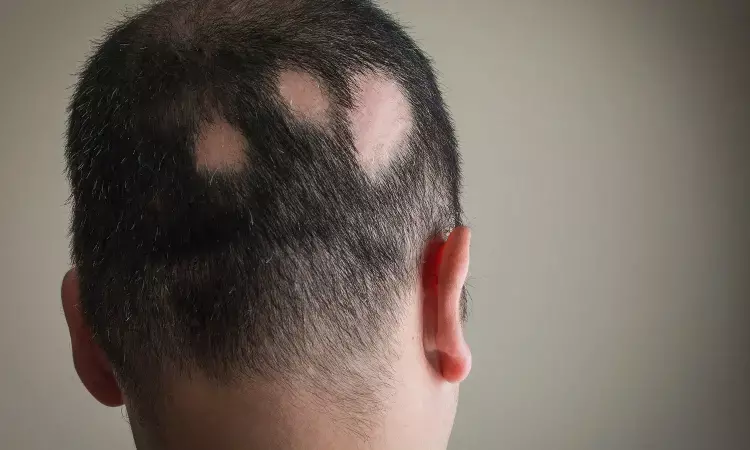- Home
- Medical news & Guidelines
- Anesthesiology
- Cardiology and CTVS
- Critical Care
- Dentistry
- Dermatology
- Diabetes and Endocrinology
- ENT
- Gastroenterology
- Medicine
- Nephrology
- Neurology
- Obstretics-Gynaecology
- Oncology
- Ophthalmology
- Orthopaedics
- Pediatrics-Neonatology
- Psychiatry
- Pulmonology
- Radiology
- Surgery
- Urology
- Laboratory Medicine
- Diet
- Nursing
- Paramedical
- Physiotherapy
- Health news
- Fact Check
- Bone Health Fact Check
- Brain Health Fact Check
- Cancer Related Fact Check
- Child Care Fact Check
- Dental and oral health fact check
- Diabetes and metabolic health fact check
- Diet and Nutrition Fact Check
- Eye and ENT Care Fact Check
- Fitness fact check
- Gut health fact check
- Heart health fact check
- Kidney health fact check
- Medical education fact check
- Men's health fact check
- Respiratory fact check
- Skin and hair care fact check
- Vaccine and Immunization fact check
- Women's health fact check
- AYUSH
- State News
- Andaman and Nicobar Islands
- Andhra Pradesh
- Arunachal Pradesh
- Assam
- Bihar
- Chandigarh
- Chattisgarh
- Dadra and Nagar Haveli
- Daman and Diu
- Delhi
- Goa
- Gujarat
- Haryana
- Himachal Pradesh
- Jammu & Kashmir
- Jharkhand
- Karnataka
- Kerala
- Ladakh
- Lakshadweep
- Madhya Pradesh
- Maharashtra
- Manipur
- Meghalaya
- Mizoram
- Nagaland
- Odisha
- Puducherry
- Punjab
- Rajasthan
- Sikkim
- Tamil Nadu
- Telangana
- Tripura
- Uttar Pradesh
- Uttrakhand
- West Bengal
- Medical Education
- Industry
Study finds significant rise in alopecia areata after COVID-19

South Korea: A nationwide study involving more than half a million South Koreans revealed a significant increase in the incidence of alopecia areata (AA) after COVID-19. The findings from the research letter were published online in JAMA Dermatology on January 10, 2024.
The researchers found an 82% higher incidence of an autoimmune form of hair loss for individuals versus those without a prior COVID infection (43.19 vs 23.61 per 10,000 person-years; adjusted HR 1.82) in a propensity score-matched analysis. In all groups older than 20 years; a higher incidence was seen with greater risk observed both in men and women.
The study also revealed an increased incidence of telogen effluvium -- rapid hair loss triggered by stress or other changes to the body -- among the cohort with COVID-19 compared with the control group (adjusted HR 6.40).
Jong-Seung Kim, Jeonbuk National University Medical School, Jeonju, South Korea, and colleagues add, "These findings support the possible role of COVID-19 in AA [alopecia areata] occurrence and exacerbation, although other environmental factors, such as psychological stress, may have also contributed to AA development during the pandemic."
"Plausible mechanisms of AA following COVID-19 include antigenic molecular mimicry between SARS-CoV-2 and hair follicle autoantigens, bystander activation, and cytokine shifting."
COVID-19 is associated with triggering or exacerbation of various autoimmune diseases, such as rheumatoid arthritis, inflammatory bowel disease, and systemic lupus erythematosus. Alopecia areata is autoimmune hair loss that occurs in susceptible individuals to environmental triggers, such as vaccinations viruses, and psychological stress.
There is a growing number of reports on new onset, exacerbation, and recurrence of alopecia areata after COVID-19. However, evidence is limited to support an association between COVID-19 and AA.
For their propensity score-matched study, the research team used data from the Korea Disease Control and Prevention Agency-COVID-19-National Health Insurance Service cohort from October 2020 through September 2021. The cohort included 259,369 patients with COVID-19 and 259,369 patients without COVID-19. Patients were matched along with comorbidities and demographic characteristics.
The study led to the following findings:
- Incidence of patchy alopecia areata or alopecia totalis and alopecia universalis (AT/AU) were higher in patients with COVID, at 35.94 and 7.24 per 10,000 person-years, respectively, as compared with 19.43 and 4.18 per 10,000 person-years among controls.
- The prevalence of alopecia areata and AT/AU was 70.53 and 12.39 per 10,000 person-years in the COVID group versus 52.37 and 8.97 per 10,000 person-years in controls.
- The age- and sex-adjusted incidence and prevalence of alopecia areata and AT/AU in COVID-19-infected patients were considerably higher than in the pre-pandemic period in Korea, in which incidence and prevalence of AA and AT/AU remained constant from 2006 to 2015.
"There is a need for further studies to validate the association between different populations and elucidate the causal relationship between the two conditions," they concluded.
Reference:
Kim J, Lee G, Jeong C, et al. Risk of Alopecia Areata After COVID-19. JAMA Dermatol. Published online January 10, 2024. doi:10.1001/jamadermatol.2023.5559.
Dr Kamal Kant Kohli-MBBS, DTCD- a chest specialist with more than 30 years of practice and a flair for writing clinical articles, Dr Kamal Kant Kohli joined Medical Dialogues as a Chief Editor of Medical News. Besides writing articles, as an editor, he proofreads and verifies all the medical content published on Medical Dialogues including those coming from journals, studies,medical conferences,guidelines etc. Email: drkohli@medicaldialogues.in. Contact no. 011-43720751


